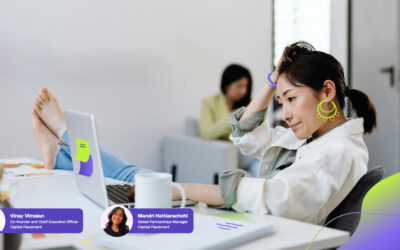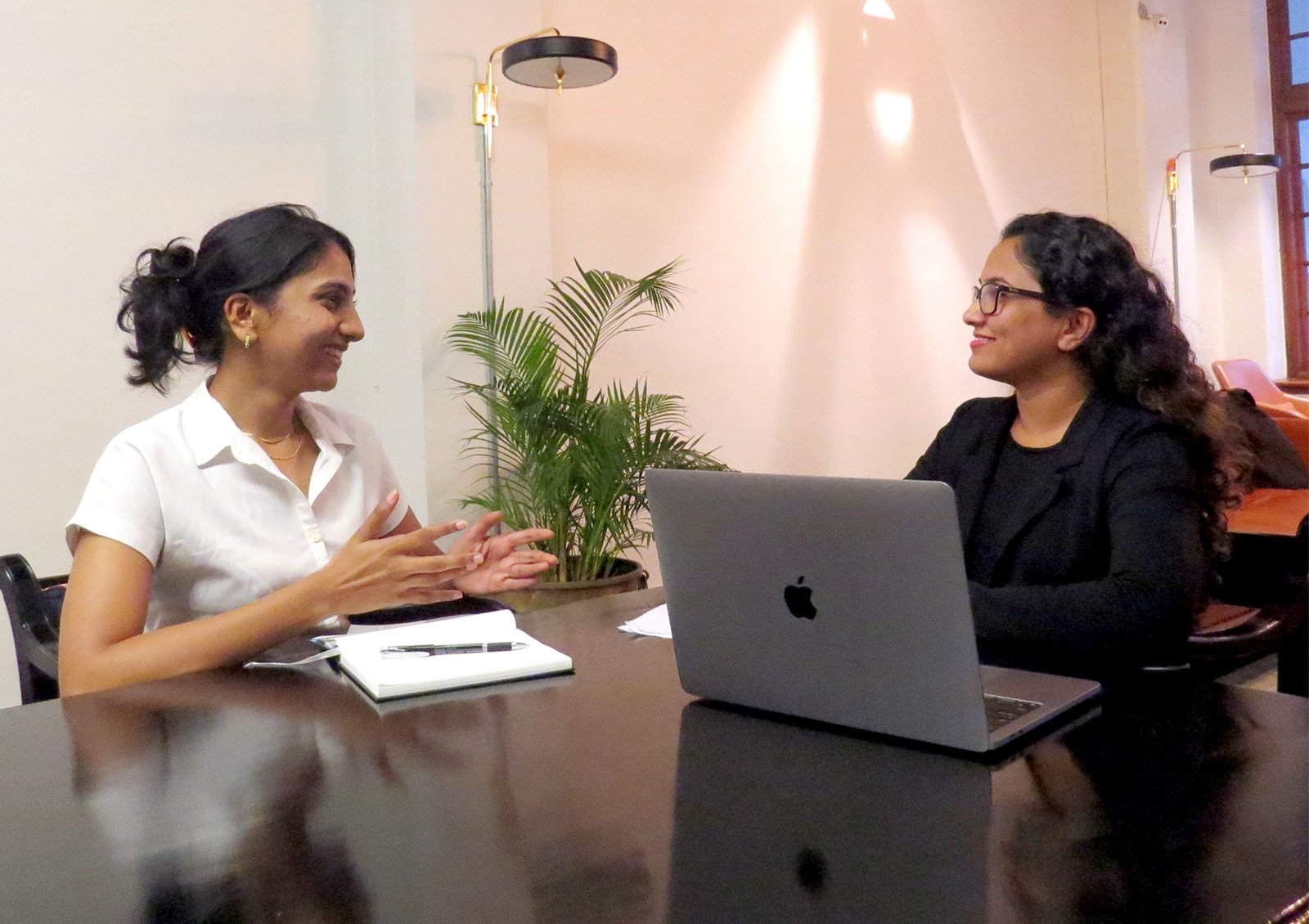
Non-verbal communication comprises anywhere between 70% to 93% of all communication. More importantly, non-verbal communication often conveys your thoughts, emotions and messages without you consciously choosing to do so. This is why interview body language is a key factor in whether or not you secure the job!
This guide will break down some crucial points that will help you up your non-verbal communication game and prepare for an interview! Let’s get started.
Defining non-verbal communication and body language
Communication is an integral part of navigating society, be it at home or in the workplace. Of that, non-verbal communication holds the most importance. Dr. Albert Mehrabian is a pioneer in the research field of non-verbal communication. He presented the 7-38-55 rule, which quantified the elements of personal communication, with 7% comprising spoken words, 38% taken up by voice and tone, and 55% by body language.
According to him, “The non-verbal elements are particularly important for communicating feelings and attitude, especially when they are incongruent: if words and body language disagree, one tends to believe the body language.”
For those of us who utilise verbal communication to actively communicate, we tend to disregard the finer points of nonverbal communication. We don’t choose how our eyebrows look when we’re angry. We don’t scrunch up our eyes when we’re deep in thought. It often just happens! Why is that?
According to the American Psychological Association (APA), nonverbal communication includes “all those kinds of human behaviour that are not strictly linguistic but convey meaning, i.e., a set of behaviours (e.g., gestures) with a specific referential value and a function.”
The study of the full origins of human non-verbal communication is, unfortunately, not conclusive. We don’t know exactly how or when it started, but what we do know is that various elements can change how our non-verbal communication is received or perceived.
Take for instance the belief that pointing at somebody is wrong. In certain countries, this sentiment is widely accepted. In others, it may seem ludicrous. Meanwhile, in one country, smiling at strangers as you walk past them may be perceived as a friendly gesture, while in others, you might end up making the stranger feel deeply uncomfortable.
Culture, mental state, lived experiences, and more, all affect how you broadcast and receive non-verbal communication.
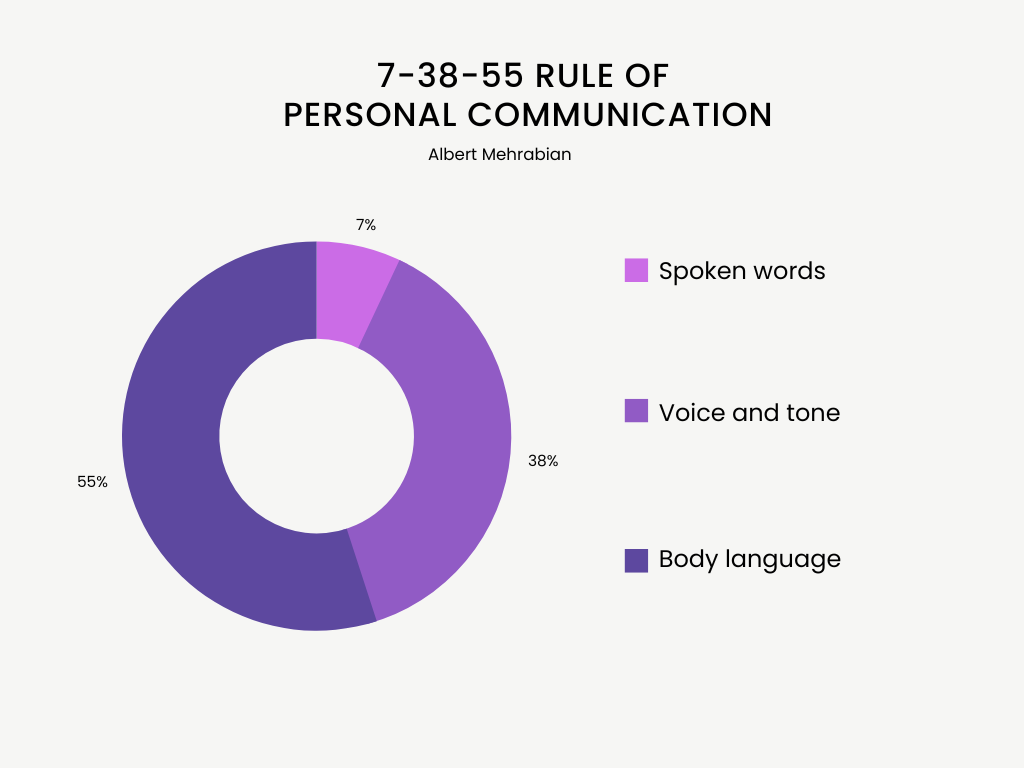
The most important role of this type of communication is that it is used to emphasise, or even “repeat”, a verbal message. It adds weight to what you’re saying and acts like an anchor for the emotions and thoughts you’re conveying.
It can even replace verbal messages entirely. For example, when your friend asks you if you’re okay, and you smile and nod your head in response, you’re essentially saying, “Don’t worry! I’m alright!”
But then, what is body language? Body language falls under non-verbal communication, but it is more specifically about your physical behaviour — or how you move your body (or part of your body). For example, crossing your arms when you’re angry is a form of body language, but the angry tone in your voice when you’re yelling at somebody is not body language. Like most non-verbal communication, body language is often more instinctive than conscious.
In addition to that, there are several non-verbal cues that form non-verbal communication. This includes the following:
- Gestures: This is how you move parts of your body, like your hand or your head. When you use your hands to draw attention to something on the board, when you wave at a friend, or when you nod emphatically while you speak about something you believe in, these are all gestures.
- Posture: This is how you hold your body and in what kind of position. This includes the way you walk, sit, and stand.
- Eye contact: The eyes may or may not be the window to one’s soul, but they sure do get a lot of attention. The way your pupils dilate when you see something you love is a form of non-verbal communication. It can also express hostility. For example, when talking to somebody you dislike, your mouth may smile, but your eyes may be telling a different story.
- Voice: How you say what you say is as important as the words coming out of your mouth. For example, if you’re rapidly rambling instructions at somebody, they will feel like you’re in a rush. If you’re very quiet when meeting somebody new, they’ll most likely assume you’re shy.
- Space: Personal space is … a personal thing. In some cultures, people are fine with shoulder-to-shoulder interactions, while in other countries, you’d be wise to give them a wide berth. How you utilise the space between you and somebody else, or the space around you, could convey a lot.
- Facial expressions: The human face is quite complex. You can express a massive range of emotions with just your face, whether you’re happy, sad, excited, angry or nonchalant. Interestingly, almost all facial expressions are practically universal. If somebody from the USA sees something gross in a video and scrunches up their face, it’s highly likely that somebody from India would be making a similar expression.
Non-verbal communication at interviews
When you’re at an interview, the person on the other side of the desk will certainly pay close attention to how you enter, how you shake hands, how you’re dressed, and the words you say. It’s a lot to keep track of, and that’s why we prepare ahead of time.
On our blog, you can find dozens of pieces on how to prepare for every situation at an interview, but here’s the problem: while it’s easy to provide specific guides and templates on how to respond to questions about your weaknesses or how to talk about your accomplishments in a professional manner, etc., it’s a lot harder to provide guides on non-verbal communication.
They’re so complex, with many minute details that are unique to each individual. That doesn’t mean it isn’t possible to consciously improve your non-verbal communication — starting with your body language.
Think about it this way. If you were interviewing somebody, and they were saying all the right things, but they looked like they were bored and uninterested in even being there, wouldn’t you feel a little hesitant about hiring them? Chances are, you would feel that way.
Body language (and non-verbal communication overall) can be beneficial to both parties involved. In this instance, just as the interviewer can read your body language, you can do the same to them. You just need to practice thinking about how you’re broadcasting your non-verbal communication and how you’re interpreting it.
Actions really do speak louder than words, so let’s talk about how your actions can make you look like the perfect fit for the role!
Greetings!
“Hello! How are you today? I’m fine, thank you.” Perfectly pleasant, not too friendly.
Now that’s a solid greeting.
First impressions are the hardest to redo. In fact, in many cases, they’re near-impossible to “fix”. This is why it’s super important to lead in with confidence and strength.
Calm your nerves with a few deep breaths BEFORE you walk into the room and keep your back straight as your enter. Pay attention to your gait. Walk at a mid-pace with medium strides, and don’t swing your arms too far out (or keep them stiffly stuck to your sides).
Smile as you enter and make eye contact with everyone in the room. Greet them efficiently and pleasantly.
Shaking hands is a big part of many cultures, and a good firm handshake leaves a solid first impression. Try not to go in for a fist bump. We’ve seen a couple of those in our time, and let’s just say … the energy is fun but there’s a time and place for everything.
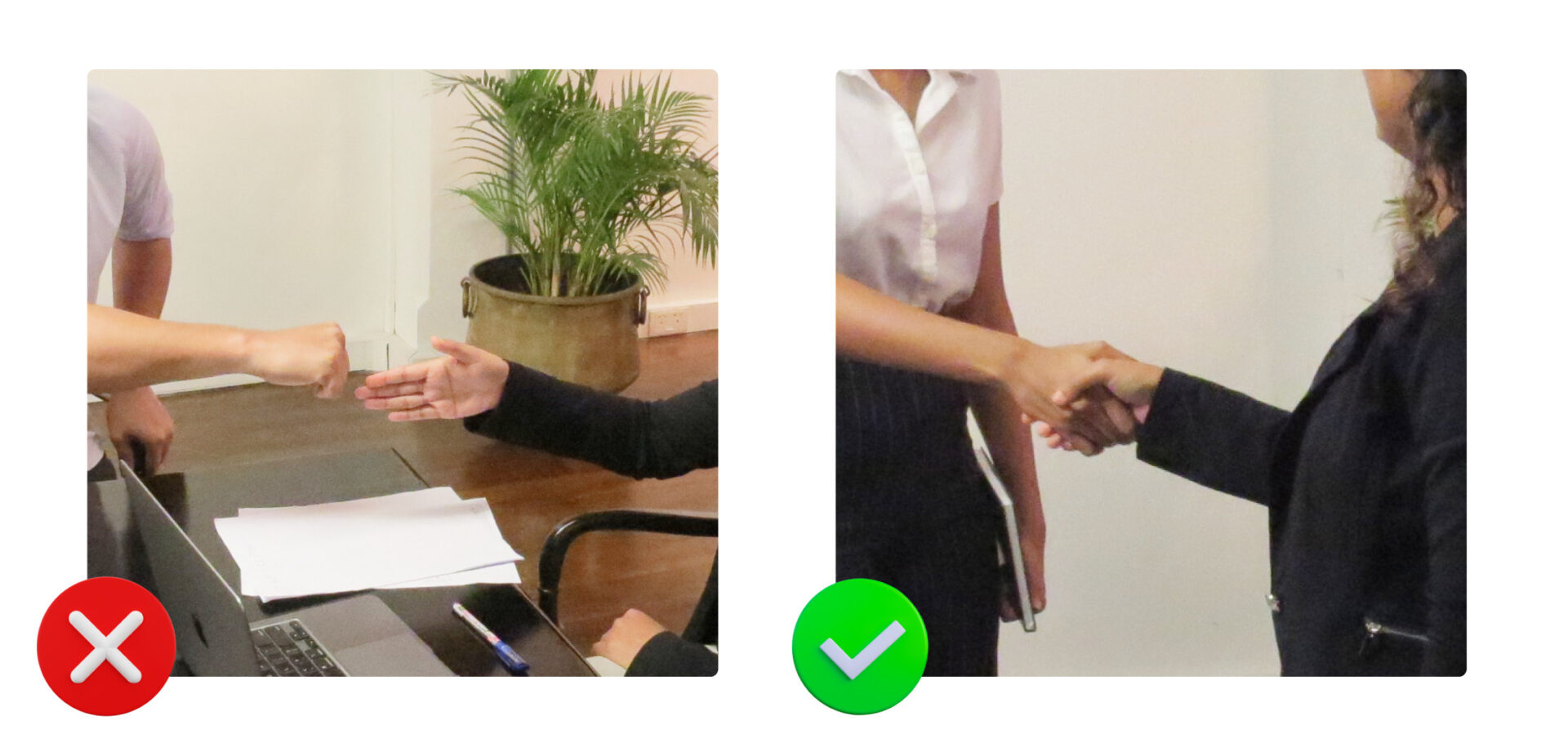
Once you’ve exchanged greetings, take a seat after you’ve been gestured towards it. Don’t sit down before the interview has (unless there are many people in the room and most of them are seated). This isn’t a strict rule, but it’s just good manners.
Facial expressions
Your facial expressions can convey a hundred thoughts and feelings before your mouth finishes a sentence. This is why a genuine smile is such a great way to make people feel comfortable around you. It exudes warmth and confidence, and people let their guard down faster.
You don’t have to paste an eager smile on your face throughout the interview. Switch it up according to what’s being said. For example, if the interviewer is talking about the company losing profit due to a certain issue, furrow your eyebrows and nod as you watch them speak. This shows concern, which is good.
Your facial expressions can make you seem more professional when used appropriately. But be careful. If you’re feeling irritated or angry (or even bored), shut that away behind a pleasantly neutral expression.
Plus, If you’re itching to be goofy … well, we’d suggest putting it off until you know for sure that this is a goof-friendly environment. Else, you’re just going to come off as unprofessional.

Making eye contact
We spoke about how the eyes get a lot of attention. Avoiding eye contact is often seen as an indicator of guilt or that you’re hiding something. This may not be true for all people — or even most — but it’s common enough to be of significance. You want to appear trustworthy and reliable, hence you make eye contact.

Of course, you need to know when to cut it off. Three to four seconds is a healthy, comfortable amount of time in this situation, but if you stare right into the interviewer’s eyes for 10 seconds straight, you’ll scare their soul right out of their body.
Additionally, if there’s more than one interviewer present, distribute your eye contact across the room to let them know you’re including them all as you address them.
Good posture
A good posture is important! (Especially for your spine.) We mentioned earlier that posture isn’t just about how you sit, but also about how you walk and stand. When you walk into the room, keep your back straight (not stiff like a cardboard cutout, but upright).
When seated, again, keep your shoulders down and back and straighten your spine. Avoid slouching against the chair or hunching over the desk. It’s equally important to not cross your legs or arms as you want to appear inviting and professional. Lift your chin a little higher as this helps make you look like you’re paying close attention.
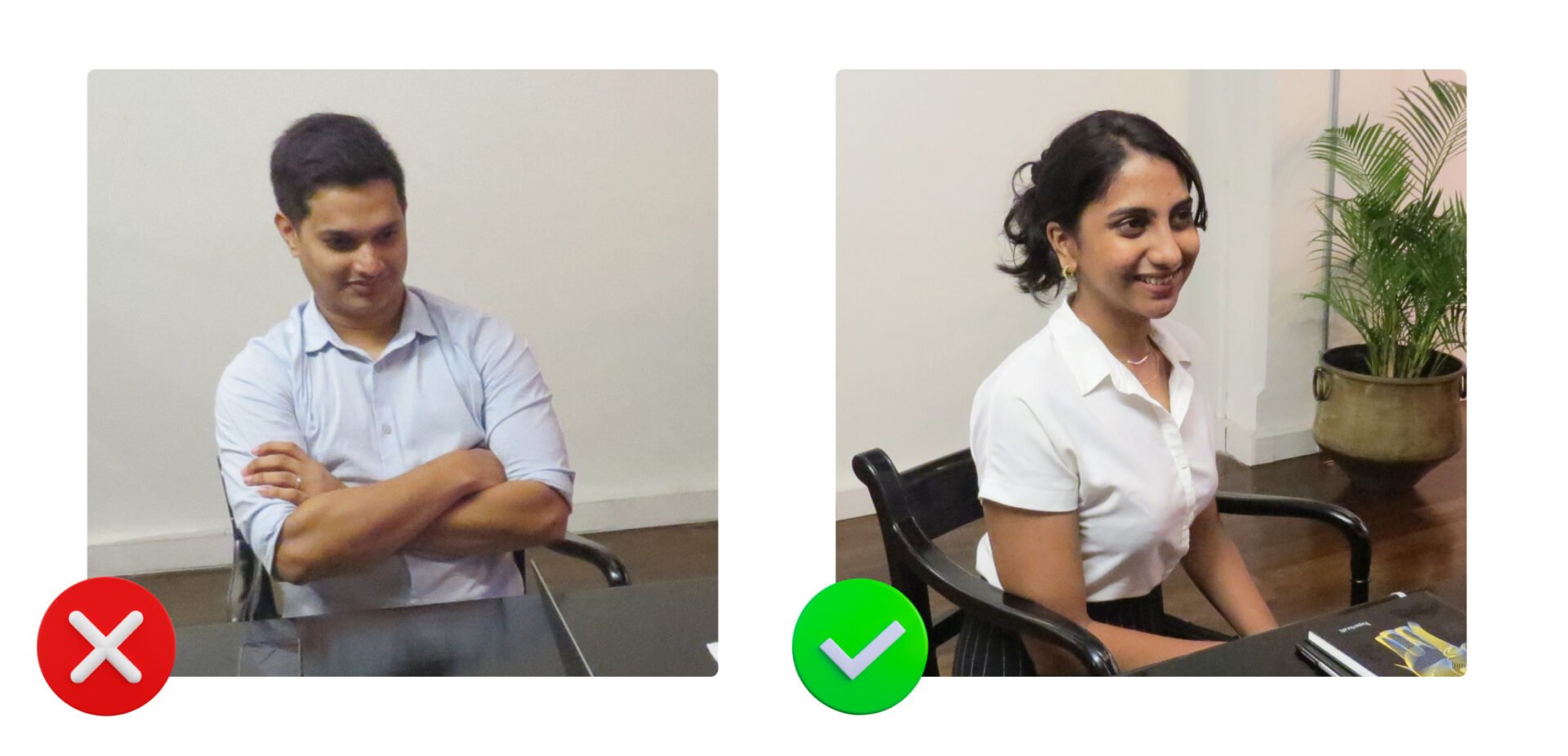
Paying attention
If you’re not paying attention, you’re disrespecting the interviewer. You would like them to be focused on you during the interview, and they expect the same of the candidates who walk in for the job.
For example, if they’re saying something positive (be it about the company or about their pet dog, etc.), smile while making eye contact. When they’re explaining something to you, lean forward a little. This body language indicates that you are interested in what they’re saying.

Another good tip that’ll make it seem like you’re paying attention is to mirror the body language the interviewer is using. For example, if they’re nodding while speaking to you, nod at a similar pace and angle as them. But don’t just throw your arms open whenever they do or stand up or lean back just because the interviewer is doing it. Keep it subtle. Pick your moments. Additionally, you can even take notes during the interview (free brownie points!) but make sure to ask the interviewer/s if it’s okay to do so beforehand.
Also, PUT YOUR PHONE AWAY. You don’t want any distractions
Using gestures
Your hands can help add a lot of emphasis to what you’re saying. The way you use them could help reign in the interviewer’s focus! This can be done in many ways. If you want to show that you’re being serious about a subject as you speak, you can place your hands together, palms pressed, all fingers pointing forward, away from you.
Opening your hands, palms out, fingers unfurled, shows openness and makes you seem more pleasantly animated and engaging. If you find yourself twirling your fingers, rubbing your thumbs together or drumming the desk, that would convince the interviewer that you are nervous and not confident. Avoid allowing these impulses to take hold. Instead, focus on using your hands in swift, brief and flowing movements to bring emphasis to whatever you’re saying.
But be careful not to wave your hands around too much, as that could have the opposite effect and distract the interviewer instead!

Final thoughts
To sum it up, non-verbal communication plays a huge part in how the interviewer perceives you — as a potential candidate and as a person. How you present yourself, whether you look friendly, whether you’re too shy, all of this can be gleaned from your non-verbal communication. This could make all the difference between a good interview and a bad one.
If you want to improve your non-verbal communication (and in particular, your body language at interviews), then you must practice. Try practising in front of a mirror. Watch your gestures and your facial expressions closely. Try regulating your tone as you answer different questions.
Additionally, you’ll find it really helps to practice with a friend or somebody you know. If you can record this test interview, then you’ll be able to review it afterwards and watch how you respond in this setting!


